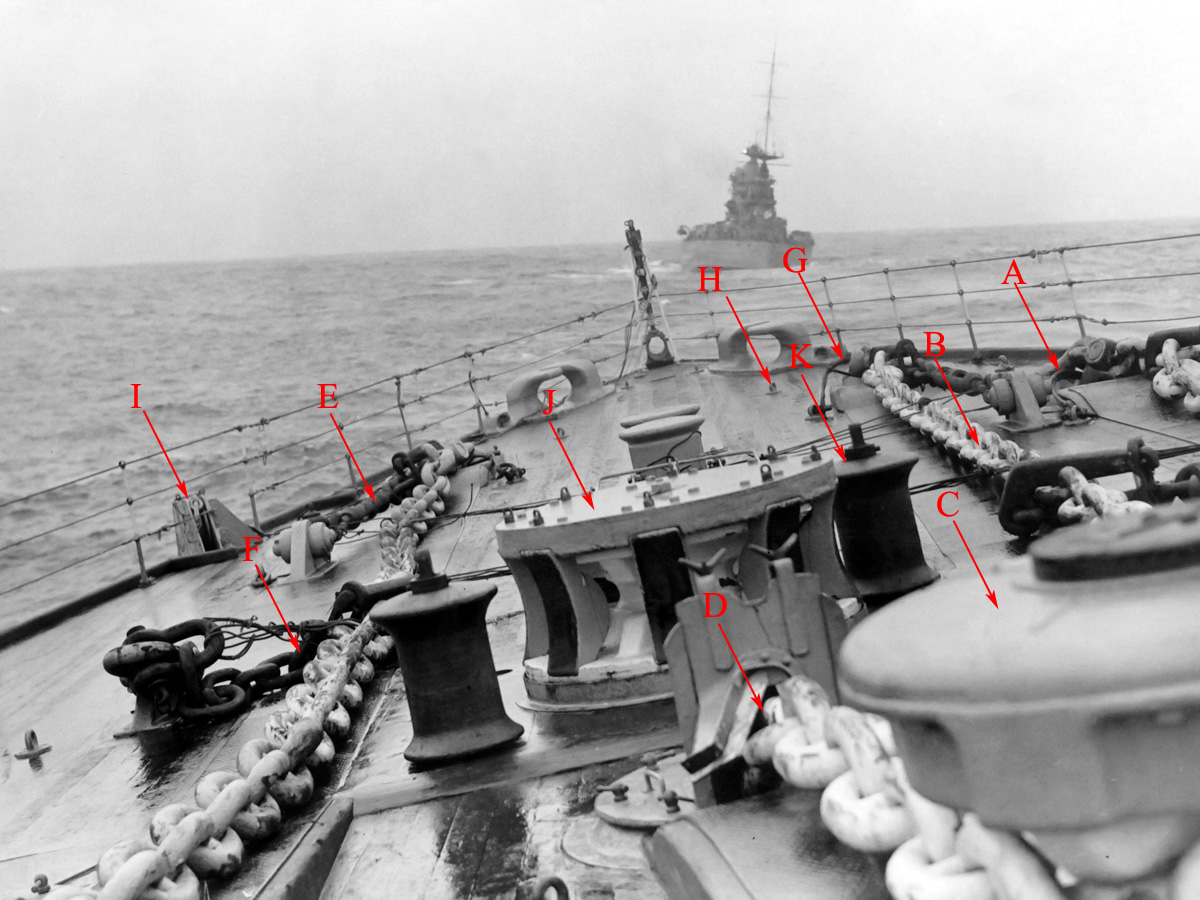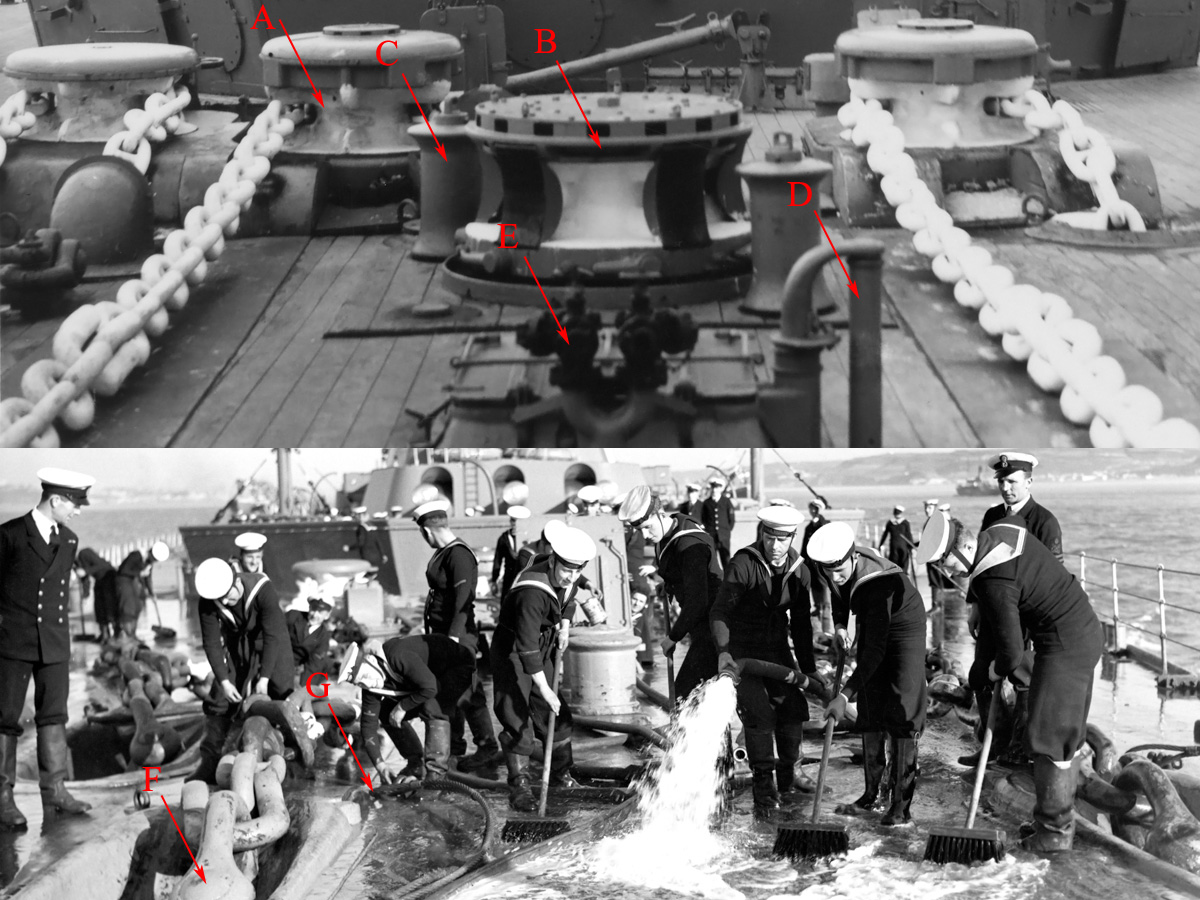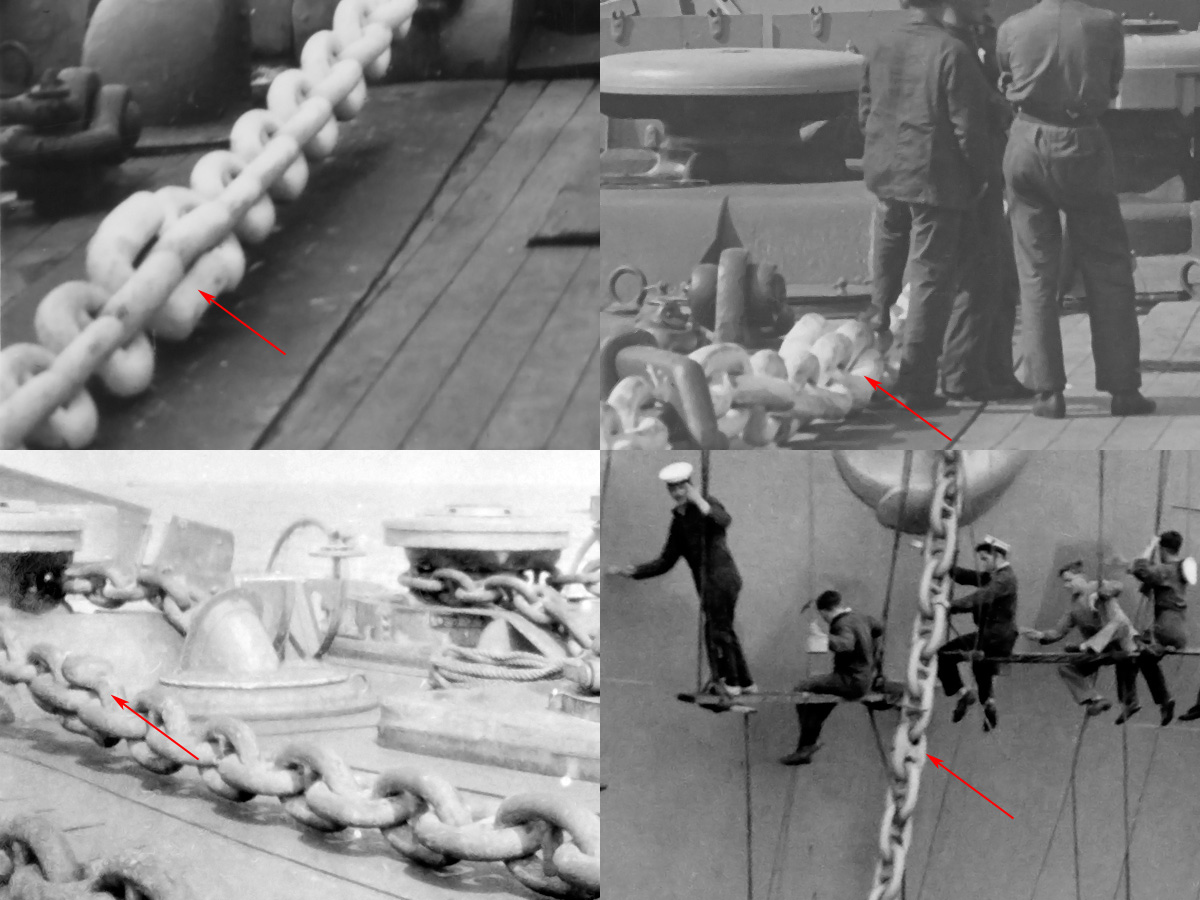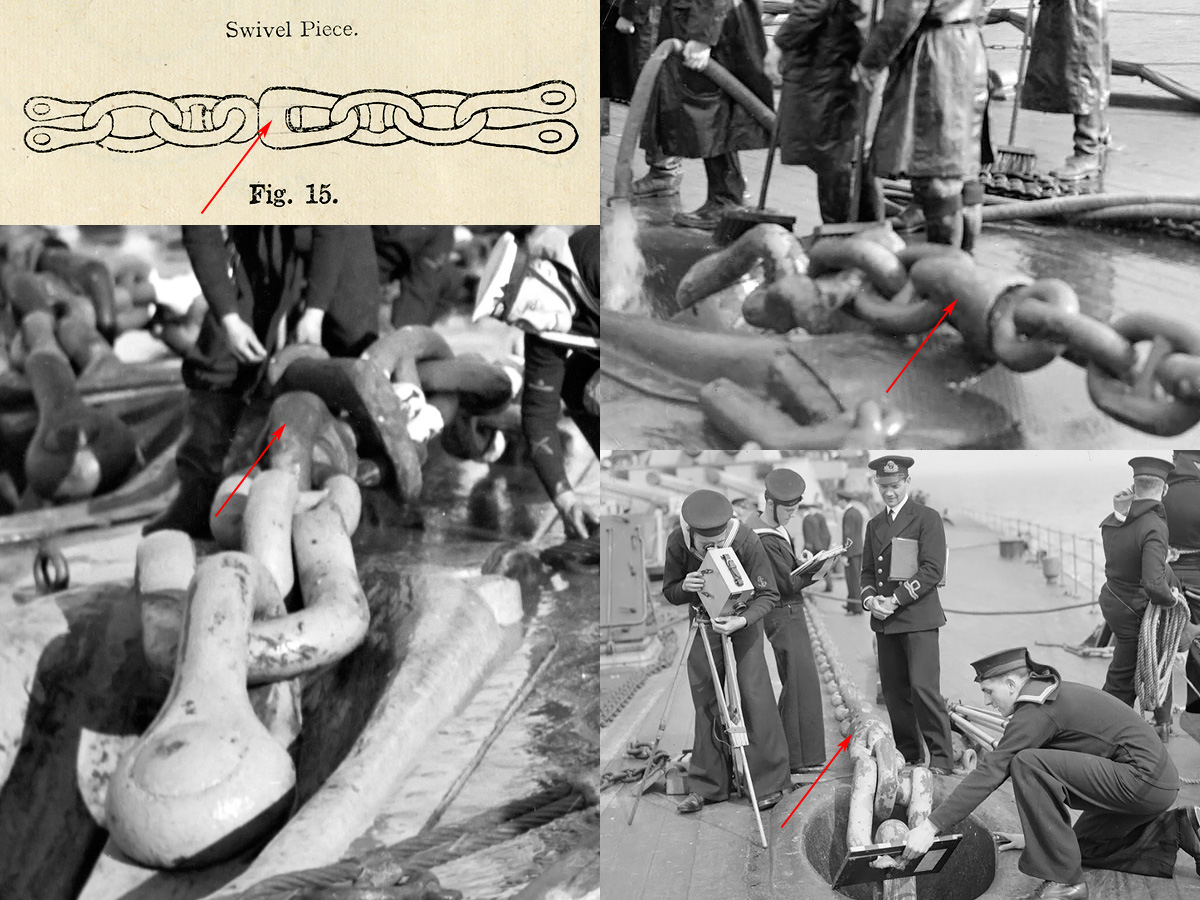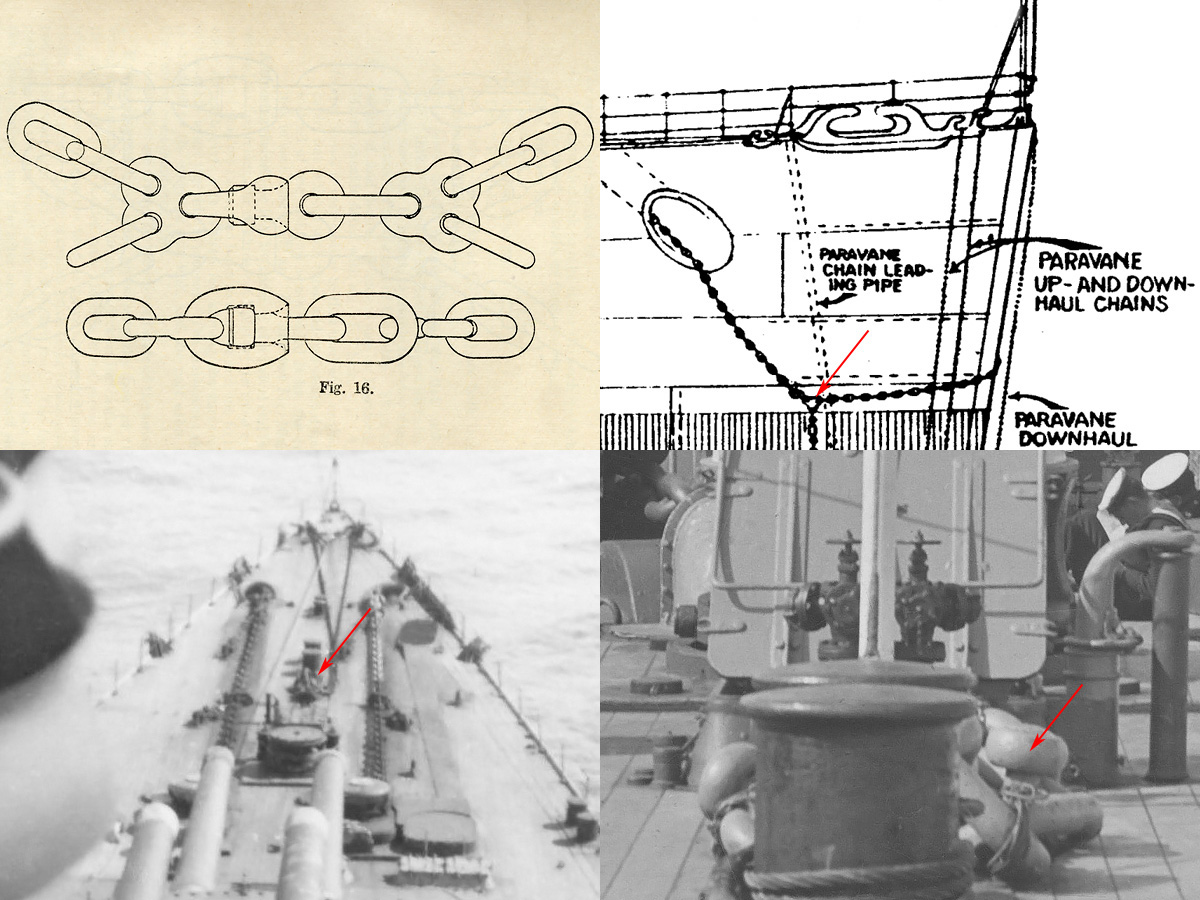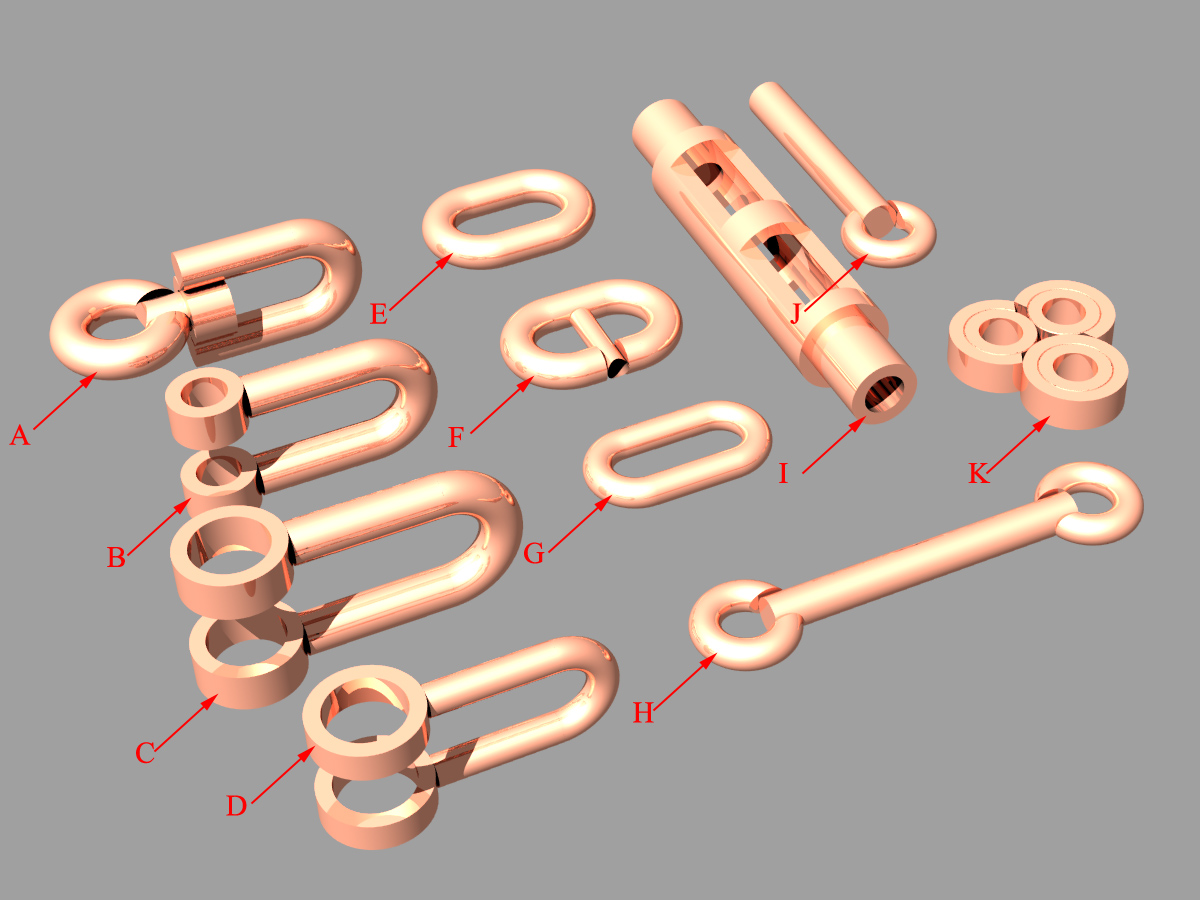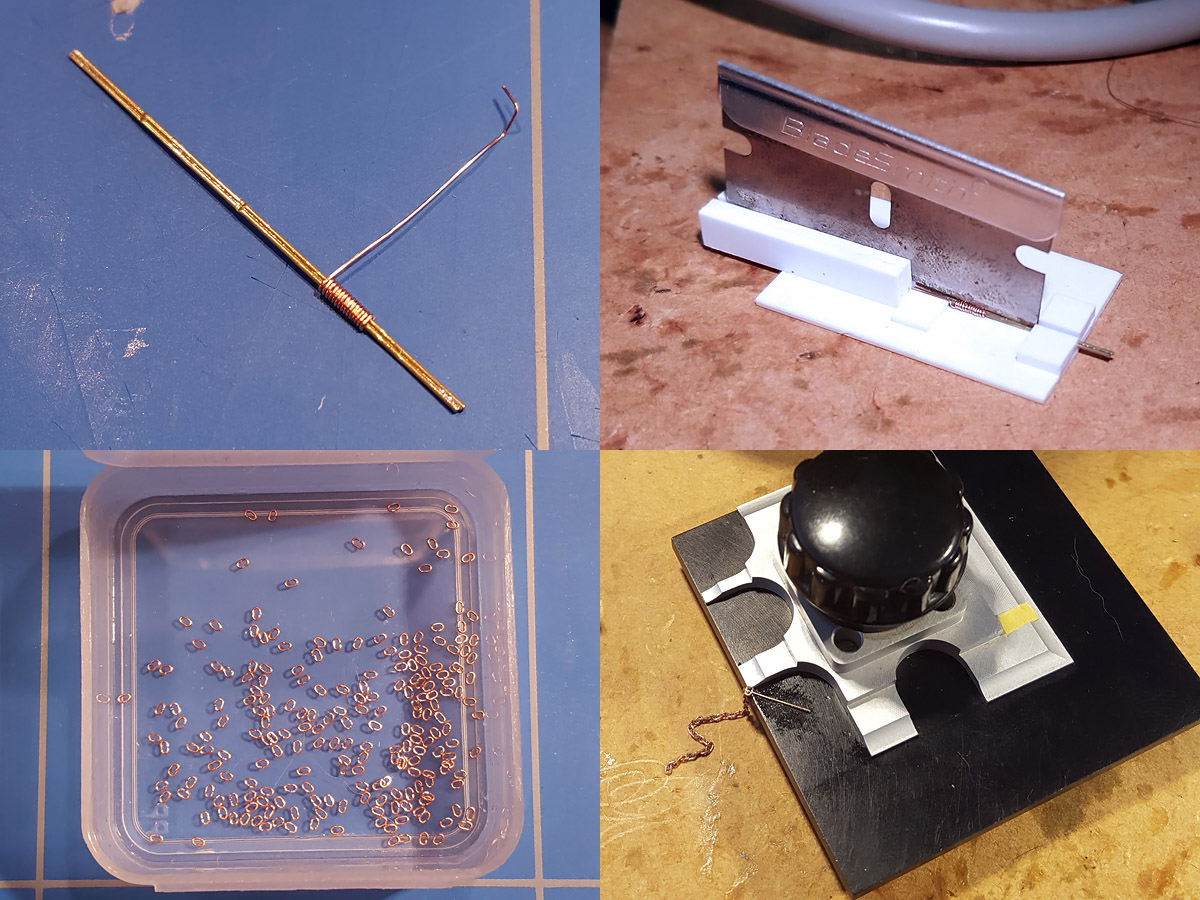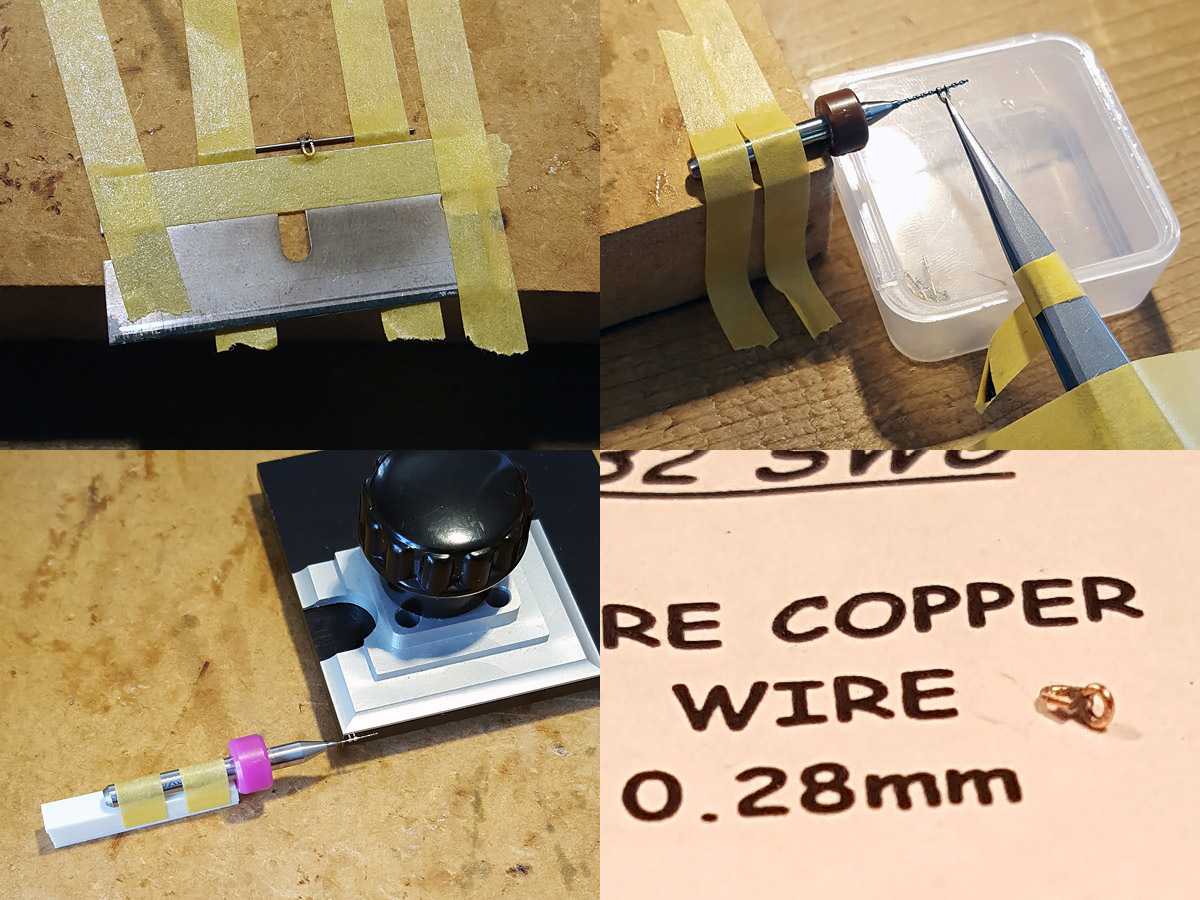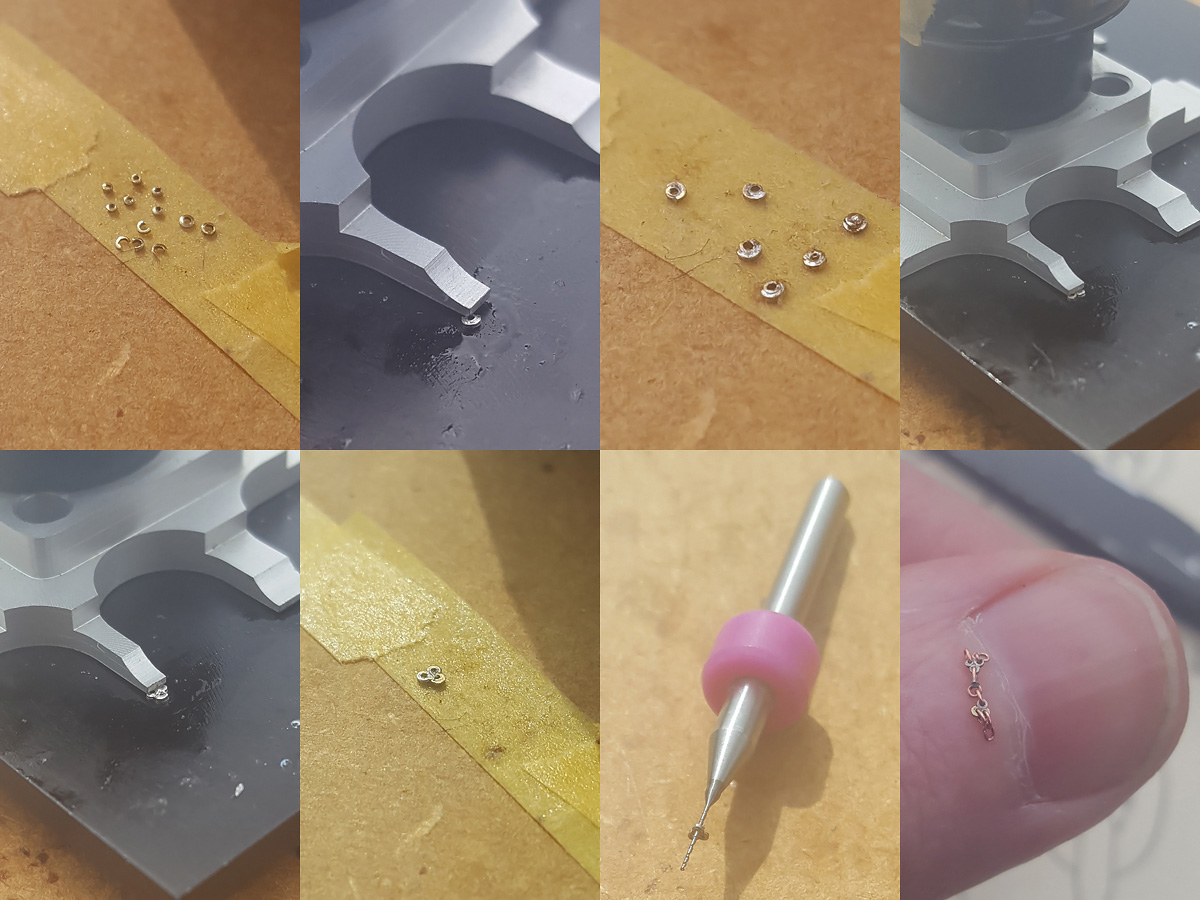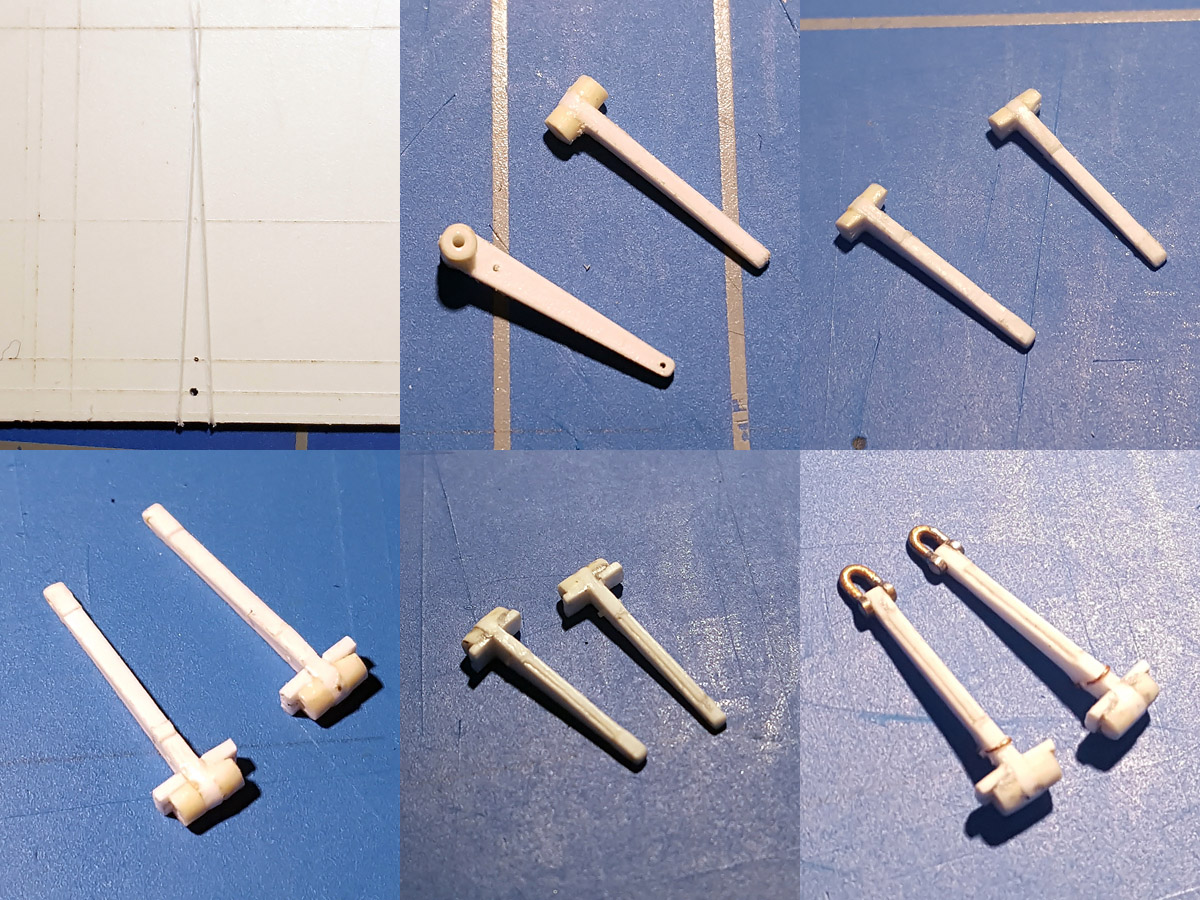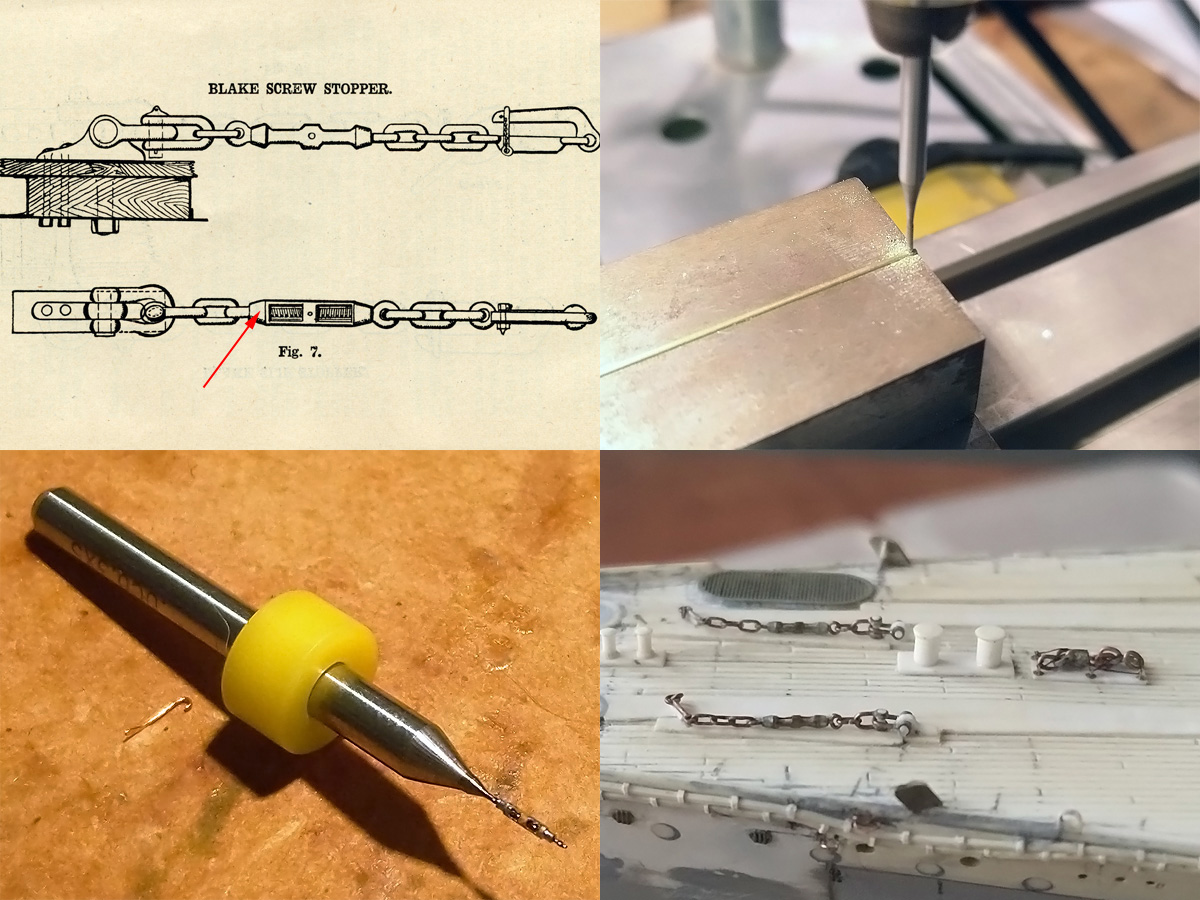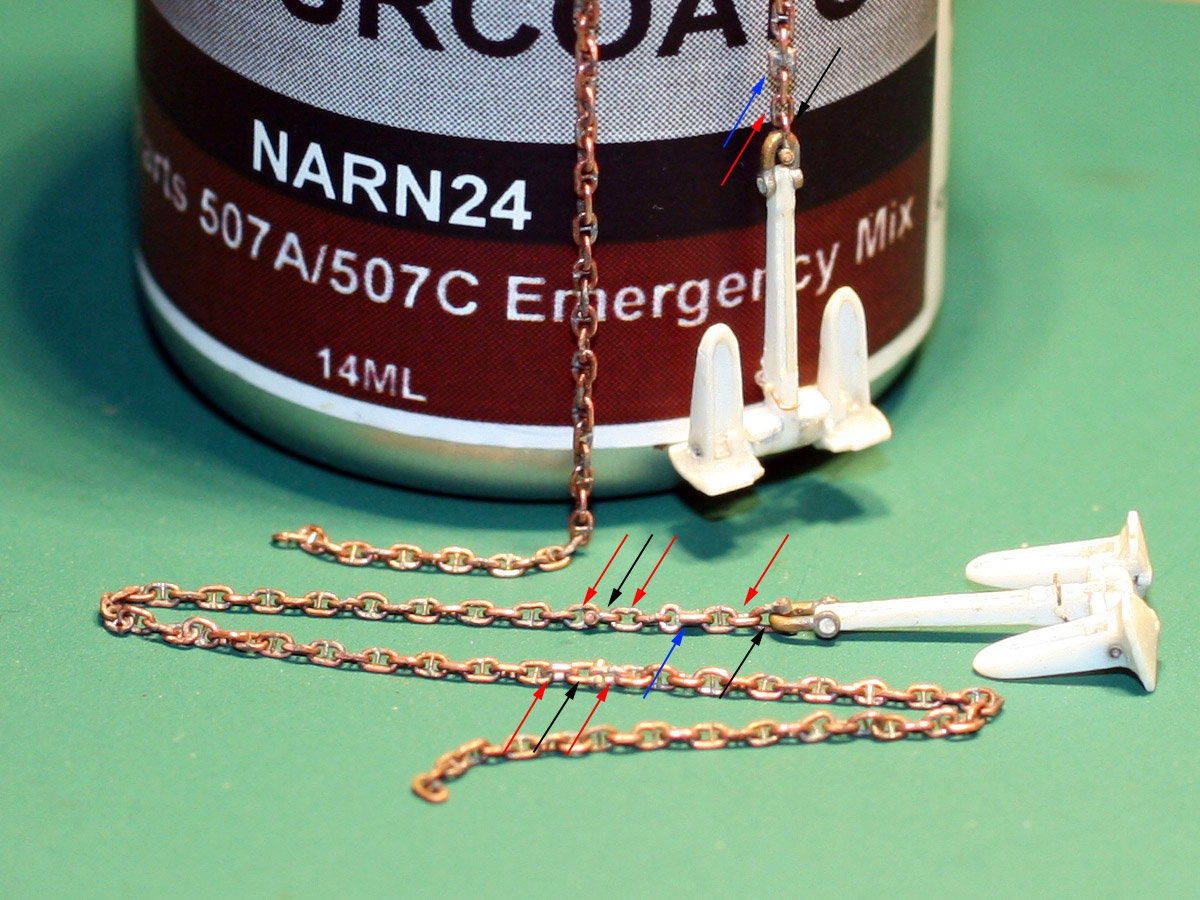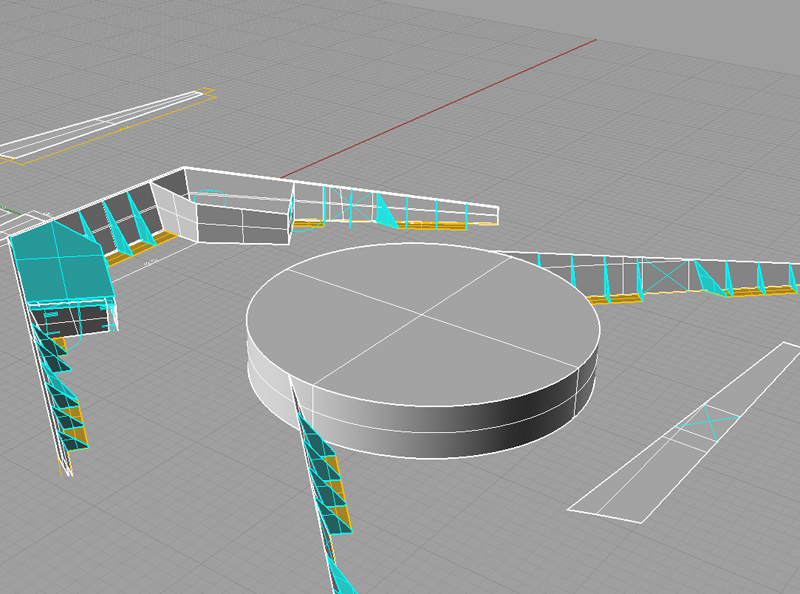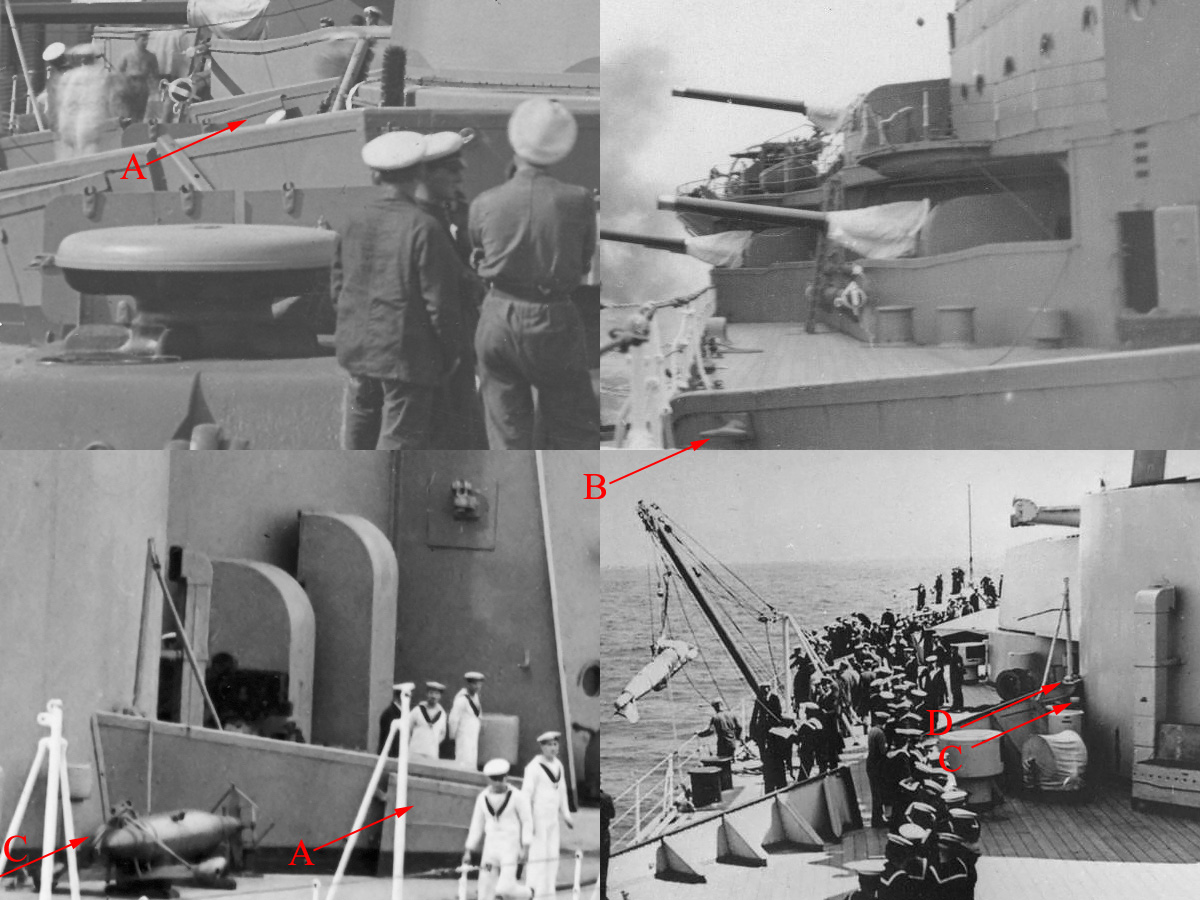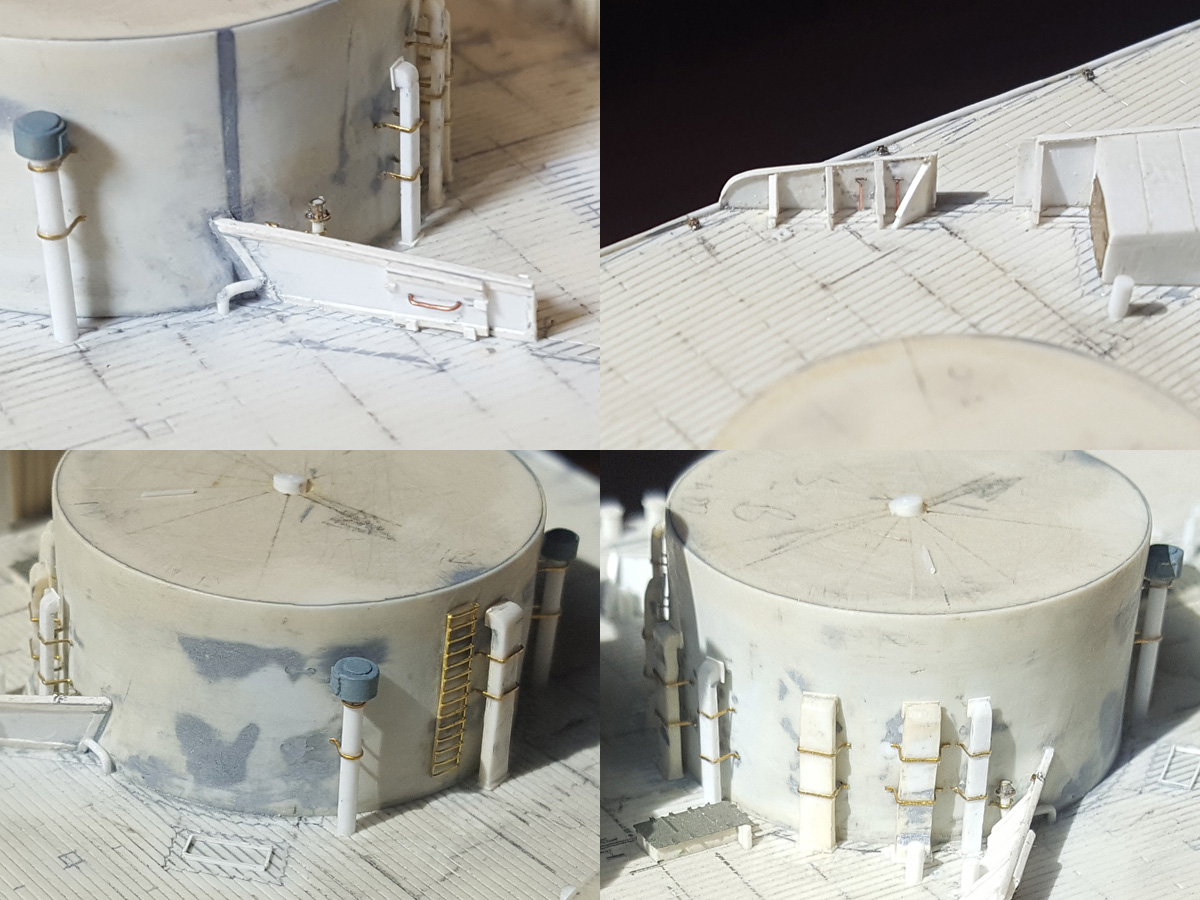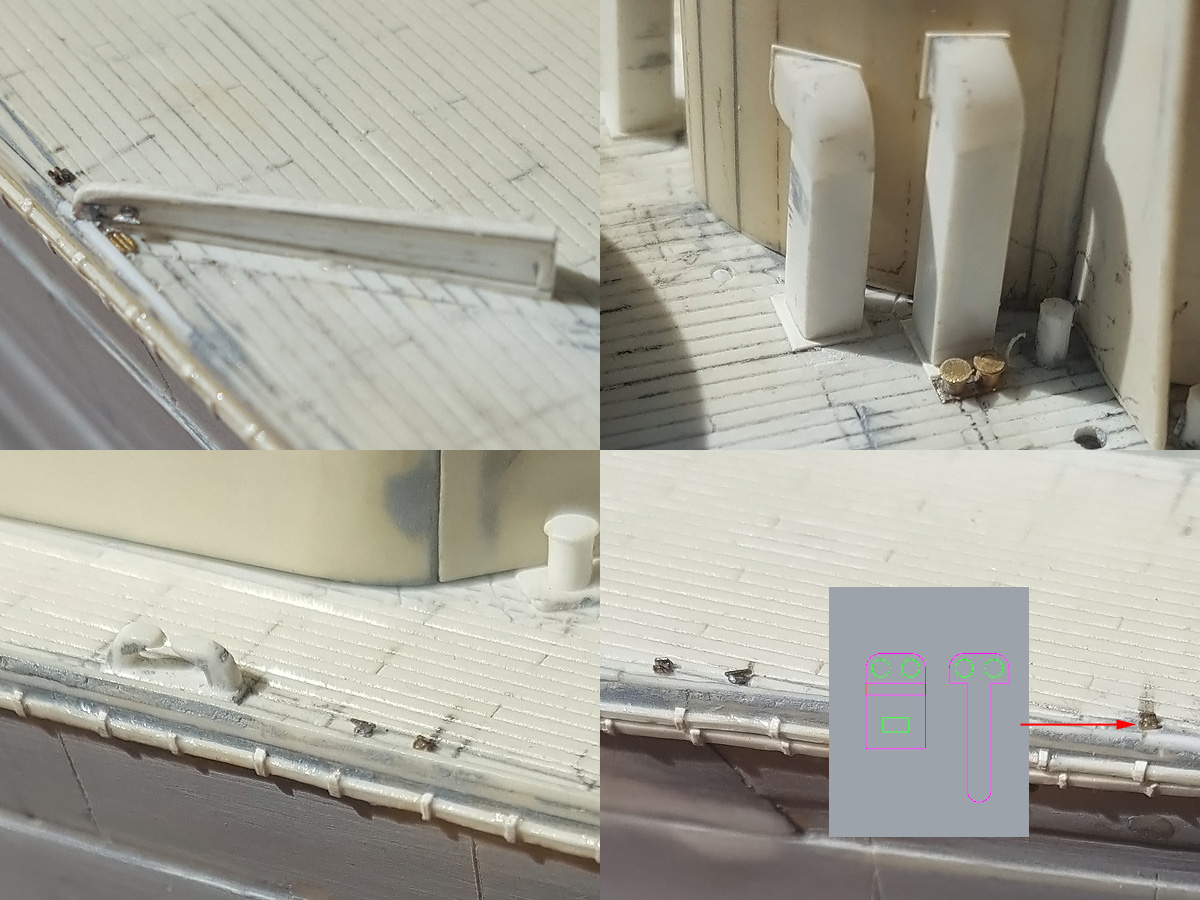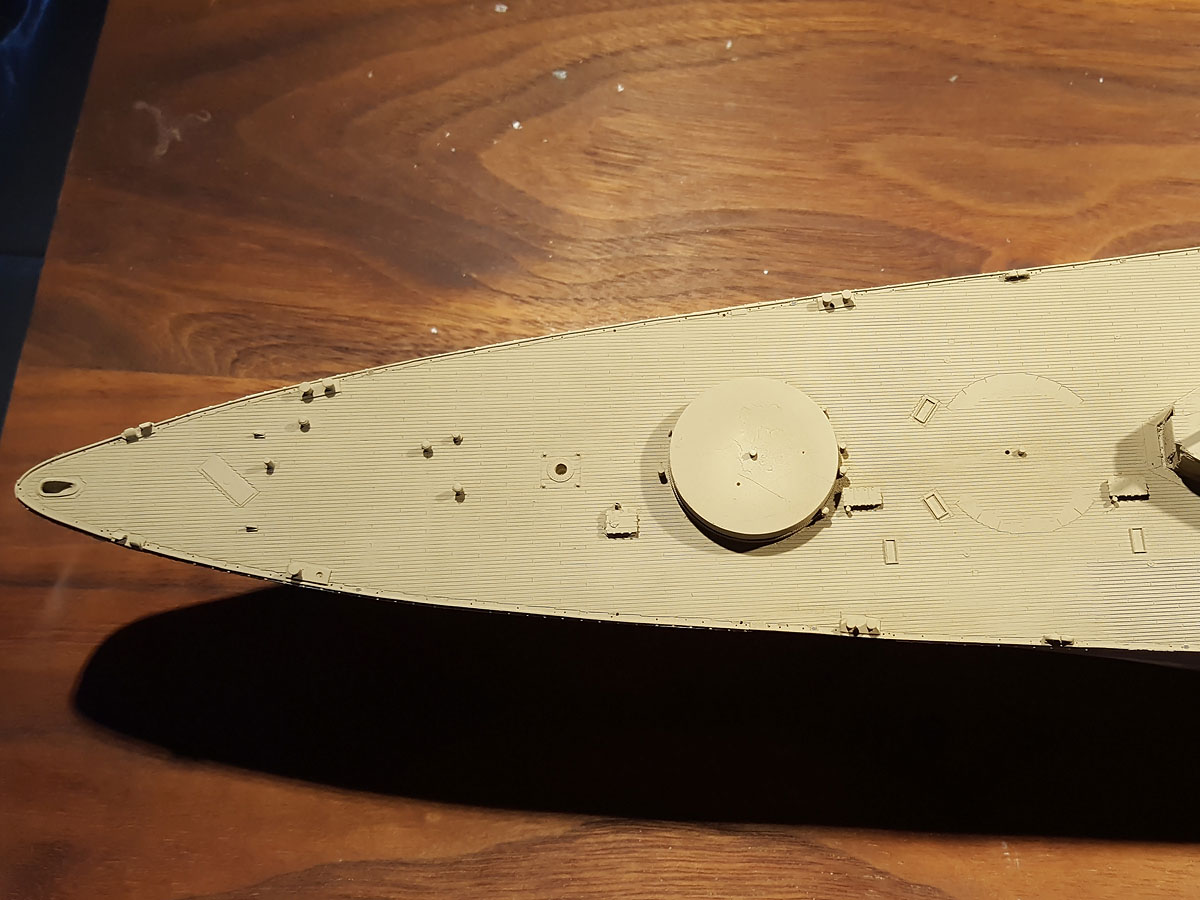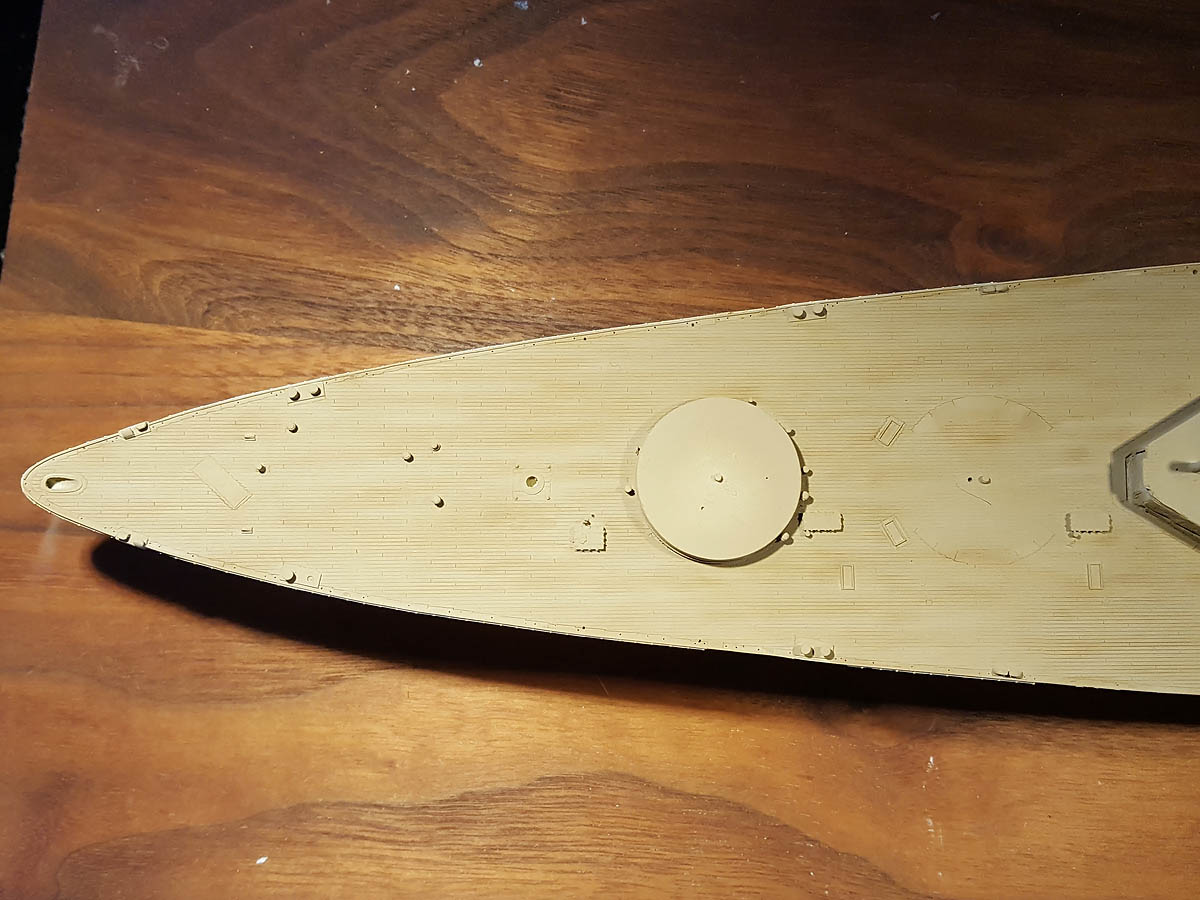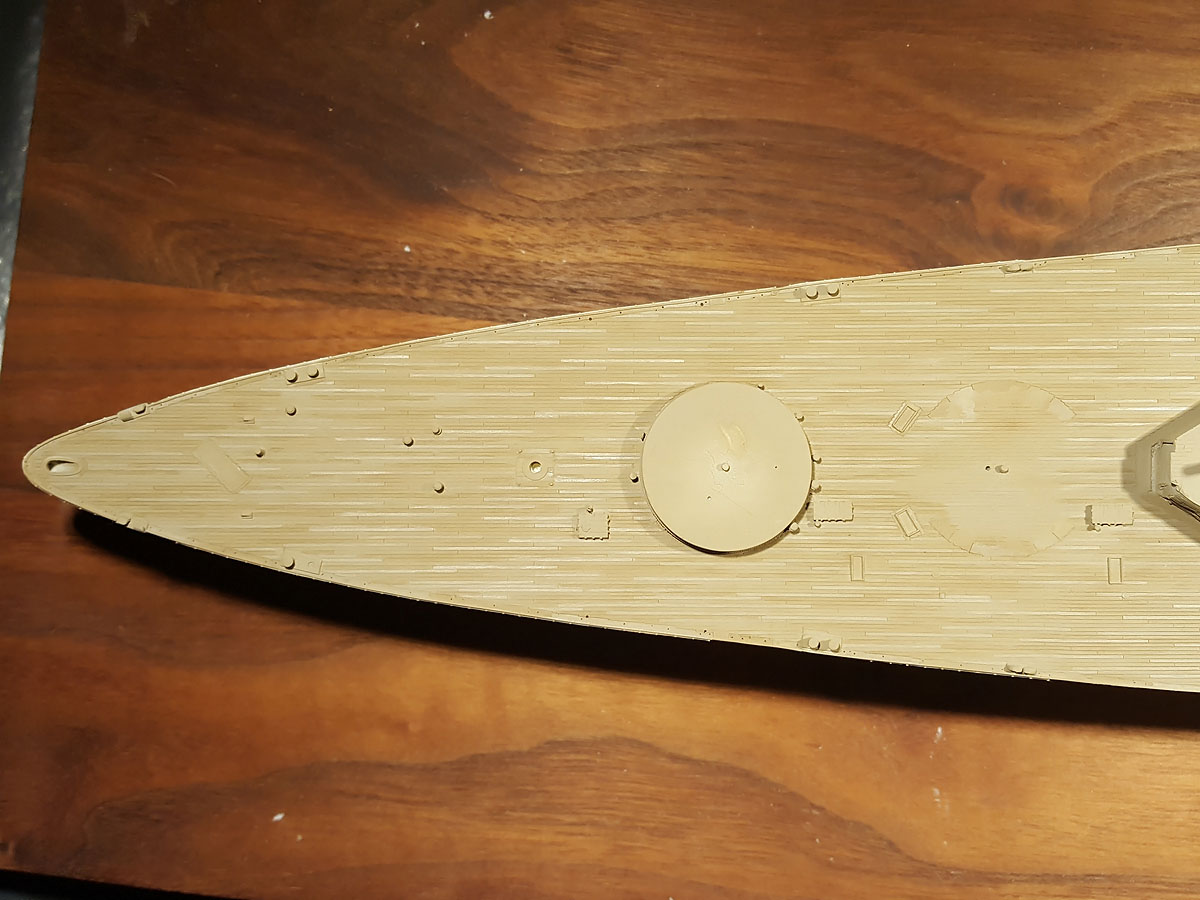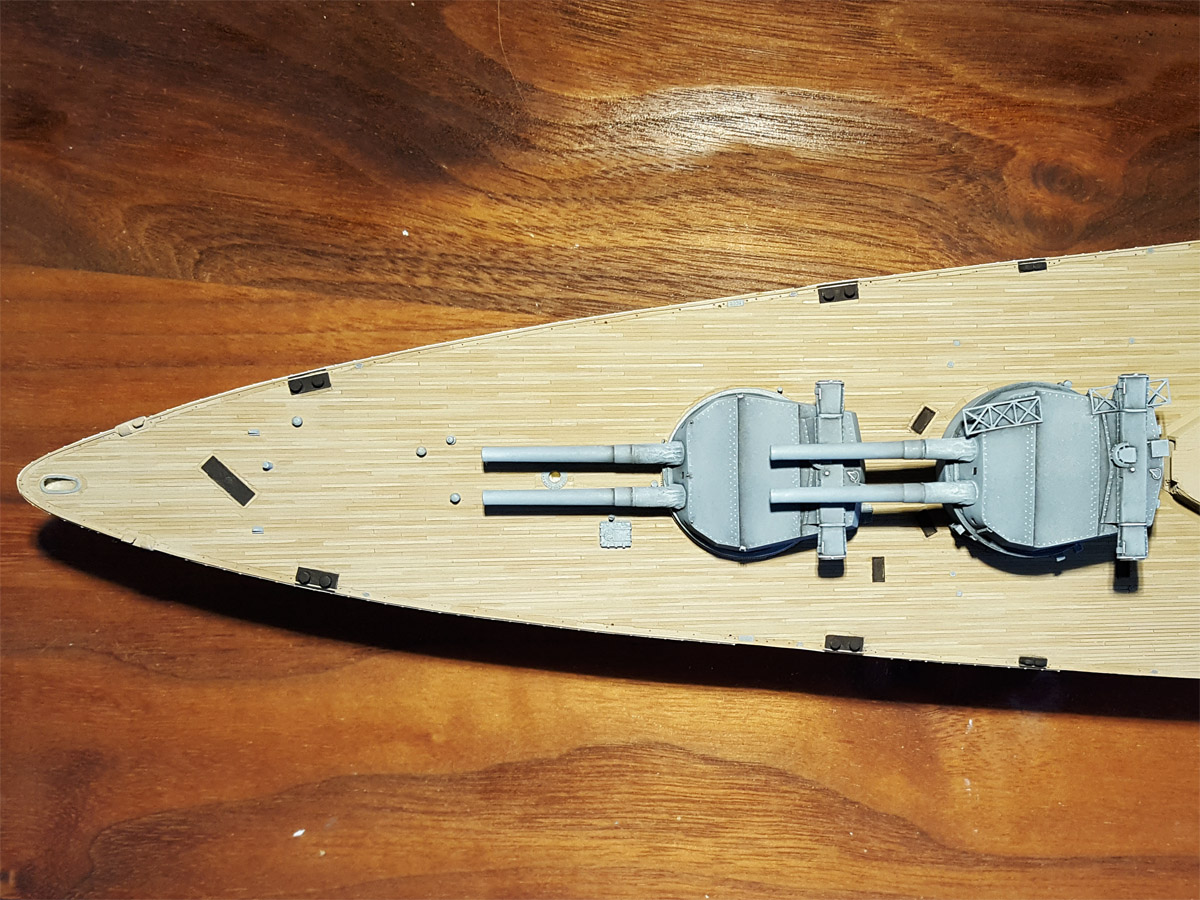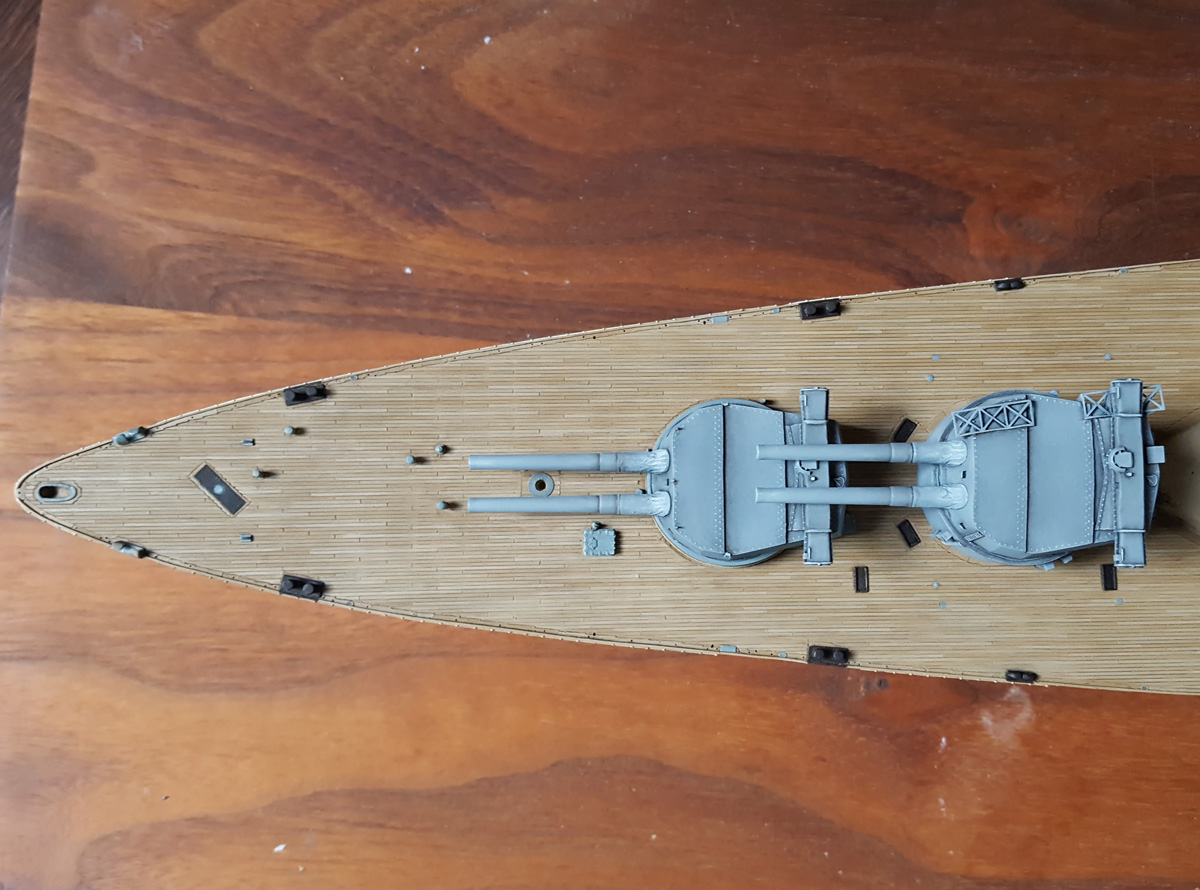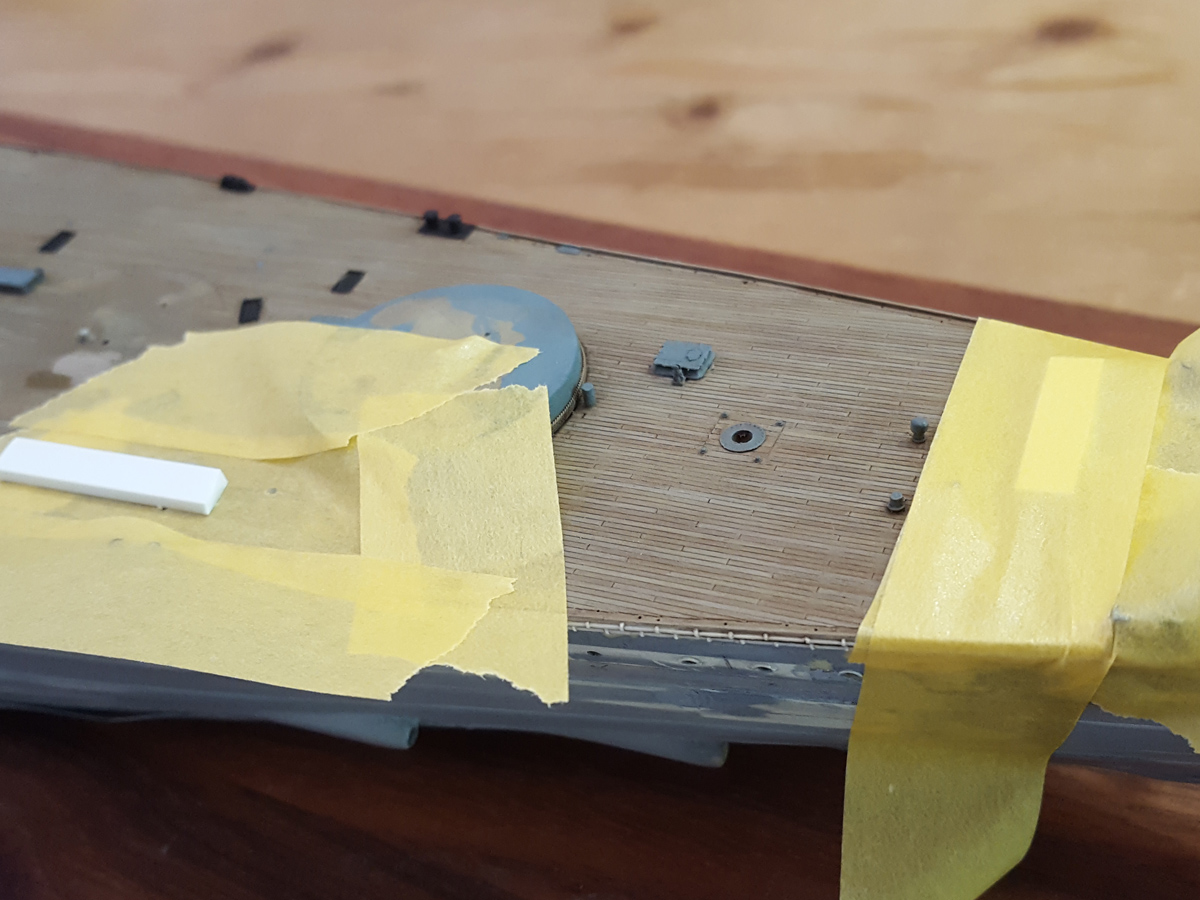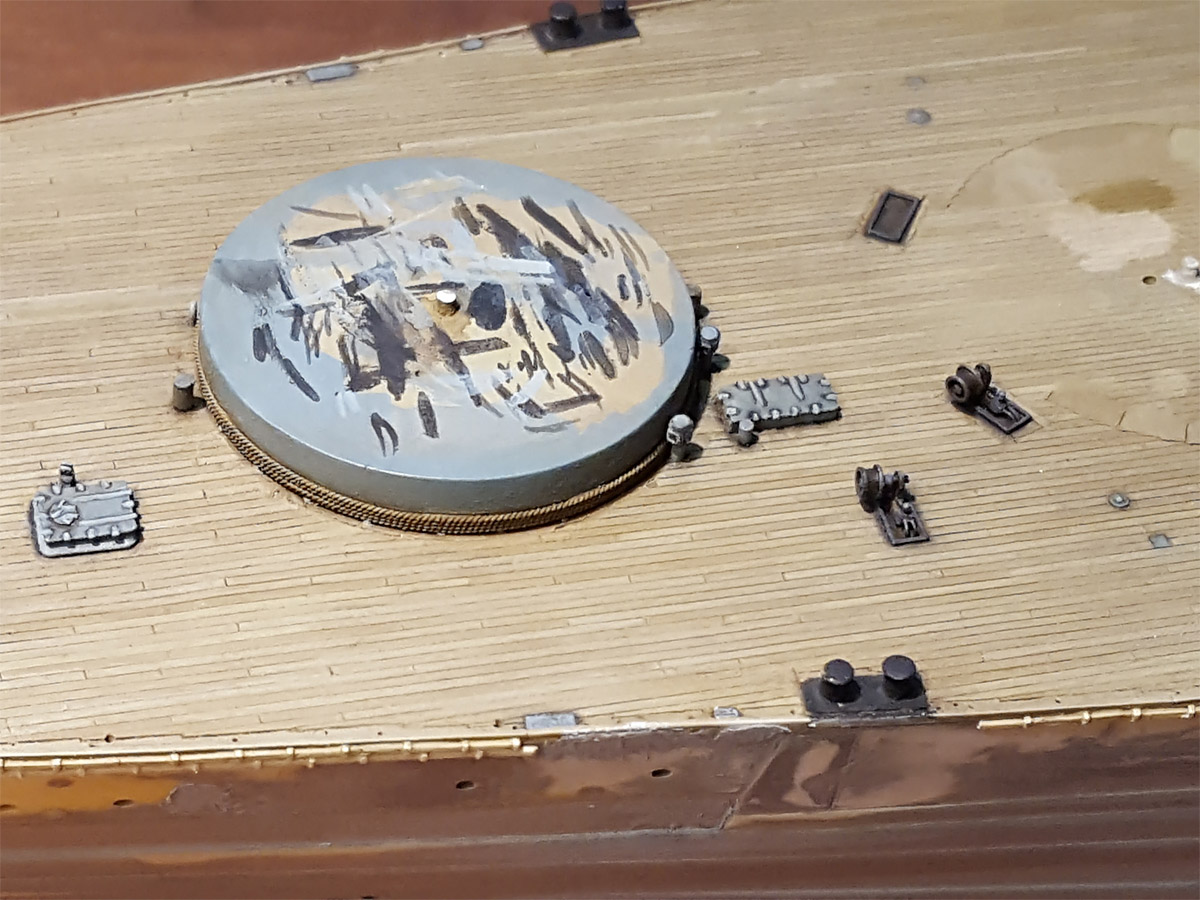While I was cleaning up the foredeck around B-barbette I noticed a bit of damage at the anchors; the link connecting the anchor to the chain was broken and this was difficult to repair. Just for the fun of it I wanted to find out if soldering studded anchor chain was doable. The studded chain previously installed was a bit over scale, otherwise fine, but why not try. In the end I decided to overhaul the entire ground tackle section of the model. As usual, this took a bit more effort than I anticipated.
You can find quite some information on anchors & cables in the Manual of Seamanship (1937, volume I) and I’d certainly recommend you find yourself a copy. Here you can see the ground tackle area of HMS Rodney. The anchors themselves are hove into the hawse pipes (A). The main anchor cable (B) runs around a cable holder (C) into the cable locker via a navel pipe (D). Inside this locker the cable is secured (see IWM image A 20535 to get an idea). There are two smaller chains on deck. Blake’s screw stopper is used (E) for heaving in and securing the anchor during sailing using a large bottle screw to apply tension; the main cable no longer carries the weight of the anchor. Blake’s stopper (F) is used only temporarily when the cable is parted at a joining shackle for mooring and other operations. Note that both the main cable and Blake’s stopper are not taut in this photograph and that several smaller lashings are present to prevent lateral movement. Additional securing lashings can be seen (G) joined to the various eyelets scattered in this area (H). When the ship is moored to a buoy, the cable is parted and the anchor is temporarily ‘catted’ at the clump cathead (I). A large capstan (J) is used by the crew to move the cables around, with the aid of a pair of support rollers (K).
Here we have a good view of HMS Hood showing the cable holders (A), the capstan (B), support rollers (C). In addition, you can see that there is a small (portable) roller next to the hatch coaming (D) and a small hydrant manifold (E). The lower half shows the crew of Rodney hosing the deck after having hoisted the anchor (F) and a crew member about to place a lashing to secure the cable (G).
The Manual of Seamanship lists that chain is supplied in shackles and half shackles; one shackle is 12.5 fathoms (75 ft). Hood carrier 35 shackles and 12 half-shackles with a single cable link diameter of 3 3/8 in. Only a very short length of the cable will be visible on deck with most of the cable stored in its locker. All the parts of the cable including all the stoppers are given in great detail in the manual, except the single cable link and its dimensions. Using the link diameter of 3 3/8 in I estimated the link length at about 18″ to 18+3/8″ inch; I must have missed that the official Hood site states 20” but that is within tolerance.
The shackles are joined by a joining shackle, a large U-shaped link with two ‘rings’ at the end—called lugs—and a pin. Note that the joining shackles must run around the capstans vertically so that the cable does not jump; this is best shown bottom left (HMS Repulse) . With the joining shackle always laying in the vertical the number of links is therefore always odd per either whole or half shackle. The top two images are HMS Hood while she is not at anchor; the position of the joining shackle on deck indicates the first run of cable from the anchor must be a half shackle (slightly more in fact). According to the AOTS Hood there is no stud in all links adjacent to the joining link and I later found a page from a Harland & Wolff ledger showing studless end links for each shackle. I could not find any photograph to confirm this but added them to the list. These studless links are slightly thicker than the common link. For all ships after WWI a lugless joining shackle was used that you can see on the bottom-right corner (HMS Rodney). This is a slightly larger version of the normal link that can be disassembled into several parts and would be less likely to damage the ground tackle or itself during operations (no studless link here adjacent to the joining shackle). The manual of seamanship states that cables must be landed every four years for testing and there must have been an opportunity to replace the joining shackles to the lugless version if this change were critical, but this did not happen.
At the anchor’s side there is a swivel piece that allows the anchor to turn relative to the cable. Joining shackles are at either end, a swivelling link is in the centre, plus a few studded and open links. These images are of HMS Rodney and one aboard a KGV-class battleship (IWM image A11507 showing a filming crew preparing a training film called “Anchor Work”).
In many cases the ship is moored, that is, using both bow anchors simultaneously, so that the ship requires less room than using a single anchor. To avoid that the cables will become foul (i.e., twist) as the ship drifts around its anchorage a mooring swivel is used. The starboard cable is connected to the single links; the port side cable to the double links. Adding this mooring swivel is a complicated manoeuvrer explained in great detail in the manual. The image above right shows such a mooring swivel in place while laying the cables; this part is usually far submerged or even on the ocean floor. Next to a swivel piece two additional triangular links are present with a series of studless and studded links.
The drawing top-left from the manual does not show joining shackles and images of HMS King George V, with a more modern version of the mooring swivel, do not show joining shackles either. Perhaps they are simply not visible or stored nearby. The mooring swivel is really hard to recognize aboard HMS Hood, but the bottom images indicate its location.
With all ingredients of the cable system identified (and a few more below) I made a small rendering in Rhino of the various components of the cable that may help as a visual reference as the final parts are so very small.
A) 3 x Swivel piece (4 parts)
B) 6 x Joining shackle, main cable
C) 2 x Joining shackle, stoppers
D) 2 x Joining shackle, stoppers
E) 18 x End cable link, no stud
F) 100+ x Common cable link, studded
G) 12 x Stopper link
H) 4 x Blake Slip (3 parts)
I) 2 x Bottle screw base (3 parts)
J) 4 x Bottle screw eyes (2 parts)
K) 2 x Three-eyed plate for the mooring swivel, 6 pieces.
The parts were made from Albion Alloy’s tubes (brilliant material) and copper wire from the Scientific Wire Company. The latter is not coated like winding wire and can be soldered more easily. I used a diameter of 0.15mm (studs), 0.20 (stopper chain links and smaller joining shackle), 0.25mm (common links, joining shackles, slip) and 0.28mm (end links and bottle screw eyelets).
Although a single real link is a heavy piece of metal, the actual links are tiny on 350 scale at about 1.3mm long. Naturally I gave the procedure a bit of thought, first trying out small pieces before going on to making the entire chain. I stared with pliers, bending around wire (drills) and such, even cutting a folded link with two knifes glued together to remove just that one slice to accommodate the centre stud. I also experimented with a series folding jigs whereby a length of brass wire cut to size would be transformed in just the right link, but the results were inconsistent.
The last attempt was much easier; wrapping a wire around a folding template consisting of two 0.4mm brass rods soldered together. The links were cut using a template, flattened, and sorted into good and bad cuts. Usually if the cut isn’t centred the entire batch is lost, but otherwise this method had a good production rate. For cutting I (gently!) tapped the back of the razor and repeatedly with a small hammer; the two brass rods only last a few batches. Then the fun part starts: soldering. The procedure is as follows: open a link sufficiently so that you can add it to the chain, close it slightly, fit the receive the stud. Clamp the link in the PE bending tool, add the centre stud wire (0.15mm) and solder away.
Normally for soldering you heat up the object with the iron and add some solder to it (with some flux), but I use the non-recommended method of adding flux to the objects and then briefly touch them with the (overheated) iron with a tiny (so tiny) bead of solder on the tip. This may lead to increased tip degradation and it’s difficult to avoid burned flux (and other debris) collecting on the tip. At first I thought that my new best friend Stannol Tippy for tip cleaning would help (and it really does) but now I blame the wetted sponge for causing most of the tip burn. I now use brass shavings to clean the tip and so far the tip remains clean.
The bending tool is a huge heat sink, so after trimming the wire another pass with the soldering iron of the link released from its clamp was required. If the wire is still there (so funny when it sticks to the iron) and the link is fine then continue to the next one. Otherwise, cut it from the chain and start over. If two links are soldered to each other there is no way to save them. The excess wire and solder can now be sanded down. With this recipe it took about 7 to 8 minutes to create a new link, so I moved at a pace of about 8 mm per hour. I actually took my soldering equipment on vacation to Normandy, postponed reading David Hobb’s latest book, put up a parasol, and progressed ever so slowly, thankful that the third anchor chain of HMS Hood was landed and deciding that my next project is better off without anchors altogether.
The joining shackles were the most difficult parts to make and I tried several recipes, with the bottom left one working well enough. The lugs are made from Albion Alloys rod. Here the failure rate was really high as it was so very tricky to have the lugs well aligned against the U-shaped wire. The larger shackles were placed on the punch of my punch&die set and soldered without the hold&fold… The swivel piece that consists of four parts was surprisingly easy to make by comparison.
For the mooring swivel I really, really, should have had the three-eyed plate in photo-etch because this was an exercise in impatience and frustration, were it not for a sunny breeze, the sound of the ocean flowing over the dunes and an ample supply of rosé. I made two plates from tube that continuously desoldered itself, broke in half during sanding or redrilling the rings.
The anchors were also already built but shattered upon removal from the model so I made a new pair. I started from plate, added some rod. A small channel was carved filled with a bit of strip.
With a bit of rod in the shank and flukes the anchor remain moveable, though they do not move together as I simply cannot get the glue to stick to both flukes at the same time. A bit of magic sculpt was used to make the pattern on the bottom of the flukes.
The screw stoppers were the hardest. The bottle screws were made from tube and “milled” using my drill press for which it is not suited. Two smaller tubes were soldered into the ends using a drill as a guide and the chamfered edges were added using superglue. Now, the tricky part was actually making sure that the stoppers were taut and suspended above the deck (1) while the anchor appears snugly fitted against the hull (2) while the clamp holds the main cable properly against a common link (3). The bottle screws could be used to correct for a bit of distance, but I thought that would be too difficult with so many parts to align. So the clamp was glued to the deck first, I hoped for the best and then I cheated by moving one the bolt forward by about 0.5mm and trimming the deck plate to size. The last part of the slip will be added once the main cable is in place. The mooring swivel is also visible bottom right lashed to six small photo-etched eyelets (many more will be added).
This small pic I took today shows the assembled cable and the anchors. The arrows indicate the position of the joining shackles (black), studless links (red) and the swivel pieces (blue).

